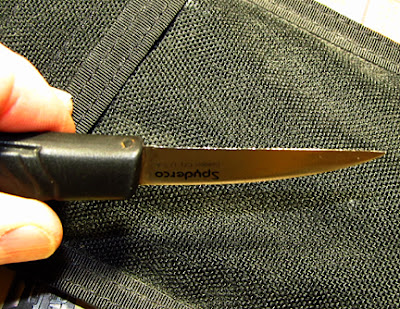I just got my hands on Benchmade’s auto knife, the CLA. I kept thinking the C stood for something
military, or governmental-like, central or clandestine. Instead it stands for the plebeian word,
composite. But don’t be fooled by that. It may say Composite Lite Auto, but it’s a
sweetie by any name.
 |
| The CLA is a relatively new addition to their black class of autos. |
The heart of any knife is the steel. The CLA has a 3.4 inch blade made of
154CM. That’s Crucible Industries’
martensitic stainless steel.
Martensitic? So much about steel
can be laid at the feet of carbon. If
steel has a low enough level of carbon, the iron is arranged in patterns called
ferrite, but it can’t hold very much carbon.
Hot iron can dissolve more carbon than cold, so as the metal cools out
of the furnace, a form called austenite develops. It can hold more carbon than ferrite,
especial when hot. Cool the hot
austenite and it has to get rid of the excess carbon like a bad check. Unfortunately by then everything is frozen
solid, so austenite does the only thing possible: it changes shape to martensite.
This change in crystal system is what gives
classic samurai swords their curved shapes, but that’s for another time.
The blade is tempered to 58-61 RHC. Martensite can be made harder, but it also
becomes brittle. Brittle is the arch
enemy of any blade. Being a stainless
the blade contains 14% chromium, which forms a transparent oxide film
protecting it from all but the harshest conditions. It’s called stain-less and not stain-proof
for that reason. The main difference
between 154CM and 440C is the higher level of molybdenum. Moly, as she’s known, also forms carbides
like chromium. These carbides help
stabilize the crystals in the steel from deforming under pressure, which provides
edge retention as well as strength. The
blades come as plain or partially serrated.
I normally prefer the plain edge based on looks, but the partial
serration looks damn good too!
Enough about steel. I
never worry if knife companies like Benchmade, SOG or even Case are using the
right steel. They wouldn’t still be in
business if they couldn’t get the best possible properties out of the metal.
 |
| Note the safety next to the large button. The button is off set to add a layer of security. |
The CLA’s handle is 4.45 inches long, under a half inch
thick and curved to better fit your hand.
The scales are composed of G-10.
This material is a composite of woven glass cloth and epoxy resin cured
under pressure. It is very mechanically
stable and resistant to most acids, solvents and bases as well as being an
electrical insulator. It’s entirely
possible when cockroaches have replaced humans as the dominant species on earth,
G-10 will still be hanging around.
Like all Benchmade autos the spring is stout enough to open
the blade with authority. Even a
superficial examination of the knife shows the safety lock next to the release
button. I’ve always liked that. You can off-safe it with your thumb and then
simply roll on to the button to open the knife.
That’s nice!
 |
| The open box construction makes it easy to clean and oil. Note the jimping at the back of the blade. |
The pocket clip is left/right reversible and the knife is
designed to be carried tip up. The clip
is placed to give you relatively deep pocket carry. A hole next to the clip provides an
attachment point for lanyards and retention devices. It’s a nice knife and if I carried it over
water or deep snow I’d use a retention line too!
The back of the blade has several lines of jimping which are
carried onto the knife handle. Jimping
provides an additional friction surface as well as another tactile indicator of
knife and blade orientation.
I wish I could tell you how it cuts, but frankly it’s not
necessary. Benchmade knows how to
sharpen an edge and how to correctly temper 145CM steel. This knife is going to cut. Besides, is slicing up a strip of cured horse
hide really going to tell you how sharp it is?



